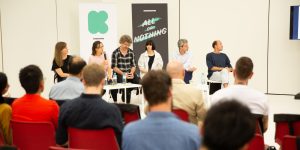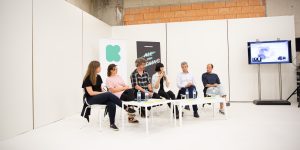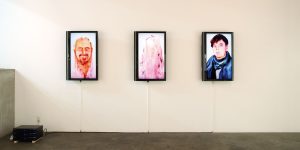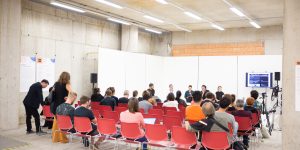future

Gallery Spaces Panel V: Artists & scientists – Exploring new forms of collaboration (Scientist in Residence Program)
Just as artists today are increasingly interested in science and technology, scientists and technologists are turning to the arts as a source of new perspectives and tools for communication. This trend requires new initiatives to establish better links between the worlds of art and science, as well as between cultural and research institutions. Through its Art&D labs, Gluon supports artist residencies in laboratories of companies, research institutes and universities. Through its Scientists in Residence programme, it encourages artists to open their studios to scientists and technologists. On the basis of their experiences in these programmes, the scientists of this panel will reflect on the following questions: To what extent can these interdisciplinary collaborations stimulate innovative ideas and projects of social relevance? What challenges do scientists have to face in working together with artists? And how can organizations help them achieve meaningful exchanges?

Gallery Spaces Panel IV: Interdisciplinary Art – how becoming established?
The art market refers to the process of art distribution and sales. Museums, galleries, collectors, curators, critics are part of the active market participants influencing the dynamics. Artists to choose interdisciplinary approaches are in need of resources, display and active discourse with all industry participants to increase awareness, understanding and appreciation for interdisciplinary work. What is needed of all industry participants to propel interdisciplinary work to a representation established level? Art and science continuously discover common questions and modes of operation, resulting however in fundamental different outcomes. These differences create friction and great space for collaborations between disciplines.

Gallery Spaces Panel III: The Potential and Limitations of the Media Art Market
The media art market is constantly changing and gradually becoming more diverse through new players such as auction houses, mega galleries, and experimental galleries. What is the progression of the art and technology market? What are the emerging trends for this market? This panel will broaden people’s understanding of the media art market and collecting as well as raise questions about not only their potential but also their limitations through a conversation between artists, collectors, gallerists, and curators.

Portraits
Nobuyuki Osaki (JP)
Meditating about myself and others. About memory and perception. About the reality of all of us, living in the information society. And also meditating about politics, society and unpredictable disasters, about our future. The more I think about it, the more “this world” is flooded with vagueness and uncertainties.

Gallery Spaces Panel II: Art & Science for Ecology
Since its creation, Quo Artis has developed a series of projects at different magnitudes that aim to reflect on our climate urgency and ecology. Among them, Artists&Scientists expedition to Antarctica in 2017 and to Galápagos Islands, scheduled for 2020. In this context and within the framework of Ars Electronica, Quo Artis presents the exhibition: “Postnature. The Future is Present” curated by Daniel López del Rincón and displaying works from the following artists: Brandon BALLENGÉE (US), Joaquín FARGAS (AR), Maja SMREKAR (SI) and the QUIMERA ROSA collective (+ Roger Rabbitch + Rebeca Paz) (ES) where they investigate the relationship between future, nature and the Anthropocene. The round table presents itself as an opportunity to put into context the works of the exhibition, while seeking to contemplate the creative potential of intersecting art and science, opening a line of escape towards a more ecological and sustainable future.


